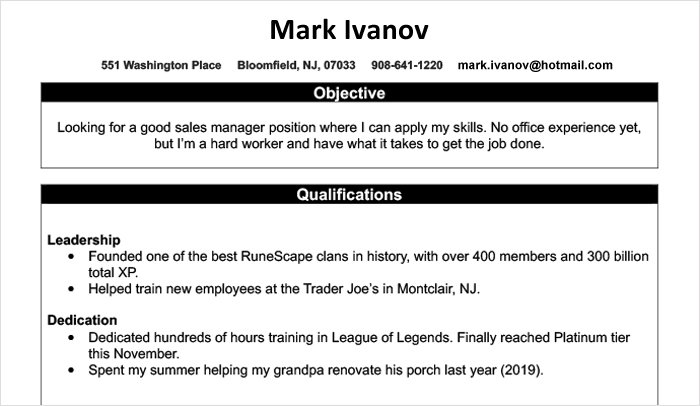15 Resume Red Flags: How to Filter Out Bad Candidates Fast

Hiring new people for your company is a massive pain.
You need talented, relevant people for your most important internal positions.
And if you’re good about advertising job openings and promoting your business, you’re probably overwhelmed with resumes and applications.
For every perfect candidate who applies to work for your company, there will probably be a dozen decent candidates and hundreds of awful ones.
If you want to save time, minimize your chances of hiring a “bad” candidate, and ultimately do right by your business, you need a strategy that can help you weed out bad candidates fast.
Arguably, the best way to do this is to generate a list of resume red flags, learn how to spot them, and apply a repeatable process that allows you to ditch resumes that have too many red flags.
What Is a “Resume Red Flag?”

A resume red flag is simply a feature of a resume that leads you to believe this candidate isn’t a good fit. As any experienced recruiter can tell you, resumes can sometimes be misleading, and you shouldn’t base your hiring decisions on only one variable. Still, resume red flags are a valuable rubric you can use to estimate the quality of a candidate at a glance.
When reviewing a resume, you shouldn’t have to read every line and every detail before making a call about whether this candidate is worth interviewing. If you did this, you would spend hundreds of hours on each position that needs filled.
Instead, you need a quick way to review resumes that allows you to fast track potentially good fits while totally disregarding candidates that could never be a good fit for your organization.
This is the resume red flag system.
The Biggest Resume Red Flags
Each organization is going to have a different approach when it comes to resume red flags.
What’s acceptable to a conservative, risk averse corporation may be totally unacceptable to a nimble, high velocity startup (and vice versa). But what follows are general resume red flags that most organizations can agree with.
1. Typos and obvious errors.
It doesn’t take much time to proofread a resume. If you’re not very skilled with English grammar or syntax, you can easily pay someone a small amount to have them proofread your resume for you. Because of this, there’s no real excuse for having typos or obvious errors on a resume.
If there’s a gross misspelling of a common word, if there are obvious font or formatting issues, or if some sentences simply don’t make sense even after reading them multiple times, it’s a sign that this candidate didn’t put much work into this project. If a job candidate is unwilling to spend a few minutes reviewing their resume, it’s usually a sign that they’re not willing to put much time or effort into their work in any situation. Even for entry-level positions, this is a hard red flag to ignore.
2. An unprofessional email address.

All of us over a certain age had an inappropriate or embarrassing Hotmail email address attached to us at some point. But by the time you start applying for adult positions at respectable companies, you should have a more reasonable, professional email handle.
Nobody wants to hire a person with an email address like “420smokin4life@hotmail.com.” It’s a sign of both immaturity and tone deafness; even if you’re okay with this email address in your personal life, you should have the good sense to avoid putting it on a resume.
3. Large, unexplained employment gaps.
Taking time off isn’t necessarily a bad thing, even if it’s between jobs. If a person has a gap of a few months between jobs, it could mean they wanted to spend more time with family, that they were pursuing other potential career options, or that they were developing themselves in some other meaningful way, such as by attending classes or getting certifications.
However, if you see large, unexplained employment gaps on a resume, it could be a bad sign. Savvy job applicants understand this, and they’ll provide an explanation to justify any large gaps that exist. For example, they may make a note on the resume That they spent this time independently training to build a new skill set.
If the employment gaps are frequent, long, or completely unexplained, it should raise some eyebrows.
4. Fluffy job descriptions.
What did this person actually do at their last job? For each position on their resume, you should find a reasonably detailed, specific description. It doesn’t need to be exhaustive, but it should give you an idea of who this person was within the organization and what role they served.
If these job descriptions are missing, if they’re overly fluffy, or if they’re so generic they could apply to almost any job, consider it a red flag. For example, it shouldn’t be enough to describe your position as one that “facilitates communication” or one that “secured positive outcomes.” In a best-case scenario, this is a sign of poor communicative ability. In a worst-case scenario, this employee did very little at their last job and they’re trying to cover that up.
5. Career stagnation.
Ideally, people gradually advance their careers. They move into roles with more responsibilities, they advance their skills, and they climb the ladder to bigger, more important positions. So, what happens if you find a resume that indicates career stagnation? Has this person been at the same level for a very long time? Have they actually reverted and gone backwards in their career?
Like gaps in employment, this isn’t always a bad sign. In fact, it could be a sign that this person knows exactly what they want out of a career – or that they’re looking for a new position specifically because they feel like they’re stagnating elsewhere. Ideally, the resume, cover letter, or application will provide an explanation of this.
6. Suspicious timelines.
Pay attention to the dates listed for each role on this person’s resume. Do they all line up and make sense? Look for any inconsistencies or details that make you suspicious. For example, does this resume indicate that this person held multiple positions at the same time? Does this make sense logistically? There could be reasonable explanations for these discrepancies, but in the absence of these explanations, take it as a red flag.
7. Exclusively irrelevant experience.

You wrote a detailed job ad for this position. Hopefully, your applicants will tailor their resumes to be specifically relevant for this position. If an application is filled with positions, skills, and descriptions of experience that don’t seem relevant for the position, it’s a definitive red flag. Not only does this person have minimal relevant experience to showcase for you, but they’ve also demonstrated that they didn’t pay much attention to the job ad initially.
The one caveat here is that some candidates, in the interest of full disclosure, will include some details that aren’t specifically relevant to the job at hand. It’s only when the entire resume (or most of it) is irrelevant that you need to be concerned.
8. Excessive personal information.
Experienced professionals understand that resumes should be focused and concise; it’s a tool for a recruiter to use to evaluate a person’s relevance for a specific position. It’s not a space for you to parade out all your accolades.
Be on the lookout for excessive amounts of personal information, or personal details that aren’t relevant for the position. Resumes should generally not include information about family life, hobbies, and personal interests (unless highly relevant to the job).
9. Verifiable inaccuracies.
One of the biggest and most egregious red flags on this list is verifiable inaccuracies. If you can prove, beyond dispute, that some of the details in this person’s resume are inaccurate, you might as well throw the resume away. There’s a good chance this candidate is lying or exaggerating intentionally to make their credentials seem more impressive than they actually are.
Even if that’s not the case, a verifiable inaccuracy means this person didn’t sufficiently verify the details of their own work history – or that they made a big mistake they didn’t bother to correct.
10. Too little experience.
The “right” amount of experience is going to vary depending on the position this candidate is applying for. But you’ll usually know too little experience when you see it. If this person has had no roles that are similar to the role they’re applying for, it’s a bad sign. If this is their first job out of college, and the position isn’t entry-level, it’s a bad sign.
11. Too much experience.
Strangely enough, too much experience can also be a bad thing. If a resume is full of former positions and previous job details, it’s usually an indication that a person has many years of experience – and that they’ll demand an excessively high salary as a result. This person may also be overqualified for this position, making them less effective than an appropriately qualified counterpart.
12. Too few pages.
A resume should, by default, be kept to one page; obviously, this is a rule of thumb that can be bent or broken in certain situations. But if the resume at hand has too few pages, or too little information, it’s usually a sign that this person doesn’t have much experience or many credentials to show. If a candidate can’t even fill out a single page of details, you probably shouldn’t take them very seriously.
13. Too many pages.
Conversely, if a resume has too many pages, don’t burden yourself with reviewing all of them. There’s nothing wrong with including an extra page if a candidate truly has relevant experience to fill it, but if your candidates are sending full books of their credentials, you can count on most of the information being fluff.
At the very least, it’s a sign this person is unfamiliar with job application and resume etiquette – or that they don’t have much respect for your time. of all the red flags on this list, this is one of the more forgivable ones, so use your best judgment with each individual case.
14. Misalignment with resume instructions.
If you’re like most employers, you probably provide instructions to job applicants for how to structure their resume, which details to include, which format to send the resume in, and how to fill out the application. If a candidate seems totally misaligned with the instructions you’ve given, it’s definitely a red flag.
For example, if you specifically instruct candidates to keep their resume to one page, and they violate this by including multiple pages, you have every right to throw the resume out without reading it. The same is true if you request specific details that aren’t provided, such as a list of references. If a candidate fails to follow simple instructions when completing a task as important as submitting a resume, they’re probably going to neglect instructions in other areas of the job.
15. Disrespect for a current employer.
Also, be on the lookout for any indications of disrespect to a current or former employer. If an employee talks badly about a previous boss or previous workplace, it could be a sign of a negative attitude that could be a problem if you choose to hire them. You should also watch for other signs of disrespectful behavior, such as sending the resume from a work email address during work hours.
If this job candidate doesn’t respect or cater to their current employer, how do you think they’re going to act if they’re hired for this position at your company? Are they going to conduct themselves totally differently or follow their existing trends?
How Many Resume Red Flags Is Too Many?
So, here’s the next important question: how many resume red flags are too many?
If there’s a single red flag on a resume, and everything looks good, should you immediately disqualify that candidate anyway? Probably not.
On the other end of the spectrum, if you see half a dozen or more red flags, can you even imagine a scenario in which the candidate redeems themselves? Again, probably not.
There isn’t a fixed number of red flags that should, by definition, disqualify a candidate. Instead, you’ll have to make this decision based on the number of applicants you’re receiving, the demands of the position for which you’re hiring, your company culture, and the amount of time you have to spend in this hiring process. Additionally, some red flags are strictly worse than others; a small gap in employment is nowhere near as egregious as an outright lie.
Under ordinary conditions, you can probably follow a “three strikes” kind of system. If you see something suspicious on a resume, keep looking. If you see a second red flag, understand that this candidate probably isn’t a good fit. If you see a third, toss the resume and don’t look back.
Recruiting and Staffing Support
Are you struggling to keep up with all the resumes you receive?
Are you tired of weeding out clearly bad candidates?
Do you need help with your recruiting and staffing efforts?
That’s why our recruiting agency is here. Contact us today for a free consultation!
- Mastering Internal Mobility: A Comprehensive Guide to Success - August 10, 2023
- Effective Recruiting Strategies in a Competitive Sales Labor Market - July 27, 2023
- 6 Essential Factors to Attract Top Talent - July 19, 2023
